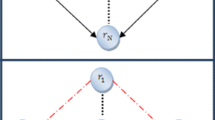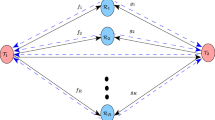Abstract
In this paper, we study joint dual relay- selection (RS) and physical network coding (PNC) schemes for wireless two-way relay channels. We propose four schemes in which the sources transmit information to the relays and two “best” relays are selected based on minimum bit-error-rate (BER) criterion. Then, the selected relays combine the received information from sources and broadcast it towards each other. The BER of the proposed schemes are obtained analytically and also verified through Monte Carlo simulations. The results indicate that the schemes have superior performance compared to an existing work which uses Alamouti space-time block codes (STBC).









Similar content being viewed by others
References
Ning, Z., Song, Q., & Yao, Yu. (2013). A novel scheduling algorithm for physical-layer network coding under Markov model in wireless multi-hop network. Computers & Electrical Engineering, 39(6), 1625–1636.
Li, Y., Louie, R. H. Y., & Vucetic, B. (2010). Relay selection with network coding in two-way relay channels. IEEE Transactions on Vehicular Technology, 59(9), 4489–4499.
Zhang, C., Ge, J., Li, J., Rui, Y., & Guizani, M. (2014). A unified approach for calculating the outage performance of two-way AF relaying over fading channels. IEEE Transactions on Vehicular Technology, 64(3), 1218–1229.
Mishra, A. K., Tiwari, S. K., Gowda, S. C. M., & Singh, P. (2019). Performance analysis of bidirectional multiuser multirelay transmission systems with channel estimation error and hardware impairment. IEEE Transactions on Vehicular Technology, 68(9), 8804–8813.
Mahdavi, A., Jamshidi, A., & Keshavarz-Haddad, A. (2017). Selective physical layer network coding in bidirectional relay channel. IET Communications, 11(18), 2691–2701.
Xie, L. F., Ho, W.-H., Ivan, L., Soung Chang, L., Lu, L., & Francis, C. M. (2017). The feasibility of mobile physical-layer network coding with bpsk modulation. IEEE Transactions on Vehicular Technology, 66(5), 3976–3990.
Huo, Q., Song, L., Li, Y., & Jiao, B. (2016). Source and physical-layer network coding for correlated two-way relaying. IET Communications, 10(5), 502–507.
Louie, R. H. Y., Li, Y., & Vucetic, B. (2010). Practical physical layer network coding for two-way relay channels: Performance analysis and comparison. IEEE Transactions on Wireless Communications, 9(2), 764–777.
Sharma, S., Shi, Y., Liu, J., Thomas Hou, Y., & Kompella, S. (2010). Is network coding always good for cooperative communications?. In 2010 Proceedings IEEE INFOCOM (pp. 1–9). IEEE.
Hausl, C., & Hagenauer, J. (2006). Iterative network and channel decoding for the two-way relay channel. In 2006 IEEE international conference on communications (Vol. 4, pp. 1568–1573). IEEE.
Popovski, P., & Yomo, H. (2007). Physical network coding in two-way wireless relay channels. In 2007 IEEE international conference on communications (pp. 707–712). IEEE.
Xue, F., Liu, C.-H., & Sandhu, S. (2007). MAC-layer and PHY-layer network coding for two-way relaying: Achievable regions and opportunistic scheduling. In Proceedings of the 45th annual allerton conference on communication, control and computing (Vol. 128).
Baik, I.-J., & Chung, S.-Y. (2008). Network coding for two-way relay channels using lattices. In 2008 IEEE international conference on communications (pp. 3898–3902). IEEE.
Madan, R., Mehta, N. B., Molisch, A. F., & Zhang, J. (2008). Energy-efficient cooperative relaying over fading channels with simple relay selection. IEEE Transactions on Wireless Communications, 7(8), 3013–3025.
Jamshidi, A. (2019). Efficient cooperative ARQ protocols based on relay selection in underwater acoustic communication sensor networks. Wireless Networks, 25(8), 4815–4827.
Jamshidi, A., Nasiri-Kenari, M., Zeinalpour, Z., & Taherpour, A. (2007). Space-frequency coded cooperation in OFDM multiple-access wireless networks. IET Communications, 1(6), 1152–1160.
Zhao, Y., Adve, R., & Lim, T. J. (2006). Improving amplify-and-forward relay networks: Optimal power allocation versus selection. In 2006 IEEE international symposium on information theory (pp. 1234–1238). IEEE.
Li, Y., Vucetic, B., Chen, Z., & Yuan, J. (2007). An improved relay selection scheme with hybrid relaying protocols. In Global telecommunications conference, 2007. GLOBECOM’07 (pp. 3704–3708). IEEE.
Onat, F. A., Fan, Y., Yanikomeroglu, H., & Vincent Poor, H. (2008). Threshold based relay selection in cooperative wireless networks. In Global telecommunications conference, 2008. IEEE GLOBECOM 2008 (pp. 1–5). IEEE.
Fares, S. A., Adachi, F., & Kudoh, E. (2009). A novel cooperative relaying network scheme with inter-relay data exchange. IEICE Transactions on Communications, 92(5), 1786–1795.
Khan, I., & Tan, C. E. (2014). The performance improvement of inter-relay cooperative wireless communication using three time slots TDMA based protocol over Rician Fading. International Journal of Soft Computing and Engineering, 3(6), 203–209.
Hu, Y., Hung Li, K., & Teh, K. C. (2012). An efficient successive relaying protocol for multiple-relay cooperative networks. IEEE Transactions on Wireless Communications, 11(5), 1892–1899.
Fares, S. A., Adachi, F., & Kudoh, E. (2008). Novel cooperative relaying network scheme with exchange communication and distributed transmit beamforming. In The 5th IEEE VTS Asia Pacific wireless communication symposiums (APWSC 2008). Sendai, Japan.
Berder, O., & Sentieys, O. (2013). On the performance of distributed space-time coded cooperative relay networks based on inter-relay communications. EURASIP Journal on Wireless Communications and Networking, 2013(1), 239.
Tran, L.-Q.-V. (2012). Energy-efficient cooperative relay protocols for wireless sensor networks. PhD Dissertation. Rennes 1.
Author information
Authors and Affiliations
Corresponding author
Ethics declarations
Conflict of interest
On behalf of all authors, the corresponding author states that there is no conflict of interest.
Additional information
Publisher's Note
Springer Nature remains neutral with regard to jurisdictional claims in published maps and institutional affiliations.
Rights and permissions
About this article
Cite this article
Keshavarz-Haddad, A., Jamshidi, A. & Ghorbani, S. Performance analysis of joint dual relay selection and physical layer network coding in two-way relay channels. Telecommun Syst 79, 529–539 (2022). https://doi.org/10.1007/s11235-021-00849-z
Accepted:
Published:
Issue Date:
DOI: https://doi.org/10.1007/s11235-021-00849-z




